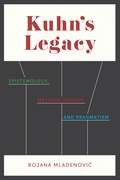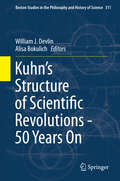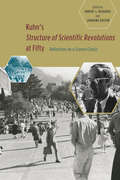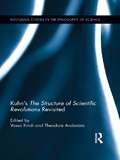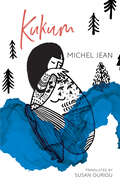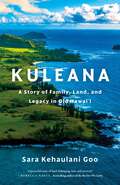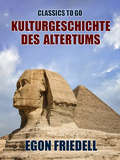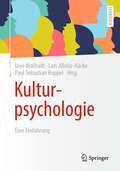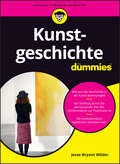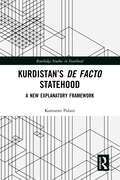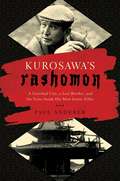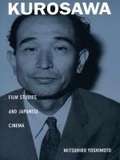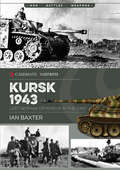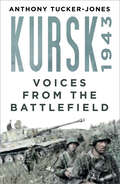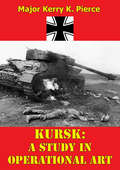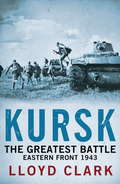- Table View
- List View
Kubrick: An Odyssey
by Robert P. Kolker Nathan AbramsThe definitive biography of the creator of 2001: A Space Odyssey, The Shining, and A Clockwork Orange, presenting the most in-depth portrait yet of the groundbreaking film-maker.The enigmatic and elusive filmmaker Stanley Kubrick has not been treated to a full-length biography in over twenty years. Stanley Kubrick: An Odyssey fills that gap. This definitive book is based on access to the latest research, especially Kubrick's archive at the University of the Arts, London, as well as other private papers plus new interviews with family members and those who worked with him. It offers comprehensive and in-depth coverage of Kubrick&’s personal, private, public, and working life. Stanley Kubrick: An Odyssey investigates not only the making of Kubrick's films, but also about those he wanted (but failed) to make like Burning Secret, Napoleon, Aryan Papers, and A.I. Revealingly, this immersive biography will puncture the controversial myths about the reclusive filmmaker who created some of the most important works of art of the twentieth century
Kudrun: with The Book of King Otnit and The Book of Wolf Dietrich
by William T. Whobrey&“I am a huge fan of Whobrey&’s translations. These new English translations of Kudrun, Wolf Dietrich, and Otnit uphold the quality to which I&’ve grown accustomed in his work. They do an excellent job of capturing the language and cadence of the texts, and are as accurate, readable, and fluent as the original texts allow them to be. &“I especially love the texts Wolf Dietrich and Otnit, and I&’m thrilled they are now available for the first time in English translation. They are such fun to read, and I hope that students find their hapless heroes as entertaining and humorous as I do. &“In short, it is a delight to read Whobrey&’s English translations of these tales, and I&’m excited to teach with them.&” —Kathryn Starkey, Stanford University
Kuhn's Legacy: Epistemology, Metaphilosophy, and Pragmatism
by Bojana MladenovićThomas Kuhn’s The Structure of Scientific Revolutions is one of the most important books of the twentieth century. Its influence reaches far beyond the philosophy of science, and its key terms, such as “paradigm shift,” “normal science,” and “incommensurability,” are now used in both academic and public discourse without any reference to Kuhn. However, Kuhn’s philosophy is still often misunderstood and underappreciated. In Kuhn’s Legacy, Bojana Mladenović offers a novel analysis of Kuhn’s central philosophical project, focusing on his writings after Structure.Mladenović argues that Kuhn’s historicism was always coupled with a firm and consistent antirelativism but that it was only in his mature writings that Kuhn began to systematically develop an original account of scientific rationality. She reconstructs this account, arguing that Kuhn sees the rationality of science as a form of collective rationality. At the purely formal level, Kuhn’s conception of scientific rationality prohibits obviously irrational beliefs and choices and requires reason-responsiveness as well as the uninterrupted pursuit of inquiry. At the substantive, historicized level, it rests on a distinctly pragmatist mode of justification compatible with a notion of contingent but robust scientific progress. Mladenović argues that Kuhn’s epistemology and his metaphilosophy both represent a creative and fruitful continuation of the tradition of American pragmatism. Kuhn’s Legacy demonstrates the vitality of Kuhn’s philosophical project and its importance for the study of the philosophy and history of science today.
Kuhn's Structure of Scientific Revolutions - 50 Years On
by Alisa Bokulich William J. DevlinIn 1962, the publication of Thomas Kuhn's Structure 'revolutionized' the way one conducts philosophical and historical studies of science. Through the introduction of both memorable and controversial notions, such as paradigms, scientific revolutions, and incommensurability, Kuhn argued against the traditionally accepted notion of scientific change as a progression towards the truth about nature, and instead substituted the idea that science is a puzzle solving activity, operating under paradigms, which become discarded after it fails to respond accordingly to anomalous challenges and a rival paradigm. Kuhn's Structure has sold over 1. 4 million copies and the Times Literary Supplement named it one of the "Hundred Most Influential Books since the Second World War. " Now, fifty years after this groundbreaking work was published, this volume offers a timely reappraisal of the legacy of Kuhn's book and an investigation into what Structure offers philosophical, historical, and sociological studies of science in the future.
Kuhn's Structure of Scientific Revolutions at Fifty
by Robert J. Richards Lorraine DastonThomas S. Kuhn's The Structure of Scientific Revolutions was a watershed event when it was published in 1962, upending the previous understanding of science as a slow, logical accumulation of facts and introducing, with the concept of the "paradigm shift," social and psychological considerations into the heart of the scientific process. More than fifty years after its publication, Kuhn's work continues to influence thinkers in a wide range of fields, including scientists, historians, and sociologists. It is clear that The Structure of Scientific Revolutions itself marks no less of a paradigm shift than those it describes. In Kuhn's "Structure of Scientific Revolutions" at Fifty, leading social scientists and philosophers explore the origins of Kuhn's masterwork and its legacy fifty years on. These essays exhume important historical context for Kuhn's work, critically analyzing its foundations in twentieth-century science, politics, and Kuhn's own intellectual biography: his experiences as a physics graduate student, his close relationship with psychologists before and after the publication of Structure, and the Cold War framework of terms such as "world view" and "paradigm."
Kuhn's The Structure of Scientific Revolutions Revisited (Routledge Studies in the Philosophy of Science)
by Theodore Arabatzis Vasso KindiThe year 2012 marks the 50th anniversary of the publication of Thomas S. Kuhn’s The Structure of Scientific Revolutions. Up until recently, the book’s philosophical reception has been shaped, for the most part, by the debates and the climate in philosophy of science in the 1960s and 1970s; this new collection of essays takes a renewed look at this work. This volume concentrates on particular issues addressed or raised in light of recent scholarship and without the pressure of the immediate concerns scholars had at the time of the Structure’s publication. There has been extensive research on all of the major issues concerning the development of science which are discussed in Structure, work in which the scholars contributing to this volume have all been actively involved. In recent years they have pursued novel research on a number of topics relevant to Structure’s concerns, such as the nature and function of concepts, the complexity of logical positivism and its legacy, the relation of history to philosophy of science, the character of scientific progress and rationality, and scientific realism, all of which are brought together and given new light in this text. In this way, our book makes new connections and undertakes new approaches in an effort to understand the Structure’s significance in the canon of philosophy of science.
Kukum
by Michel JeanA Quebec bestseller based on the life of Michel Jean’s great-grandmother that delivers an empathetic portrait of drastic change in an Innu community. Kukum recounts the story of Almanda Siméon, an orphan raised by her aunt and uncle, who falls in love with a young Innu man despite their cultural differences and goes on to share her life with the Pekuakami Innu community. They accept her as one of their own: Almanda learns their language, how to live a nomadic existence, and begins to break down the barriers imposed on Indigenous women. Unfolding over the course of a century, the novel details the end of traditional ways of life for the Innu, as Almanda and her family face the loss of their land and confinement to reserves, and the enduring violence of residential schools. Kukum intimately expresses the importance of Innu ancestral values and the need for freedom nomadic peoples feel to this day.
Kuleana: A Story of Family, Land, and Legacy in Old Hawai'i
by Sara Kehaulani GooSet in one of the world’s most beautiful landscapes, Kuleana is the story of an award-winning journalist’s effort to hold on to her family’s ancestral Hawaiian lands—and find herself along the way.“A powerful story of land, belonging, loss, and survival that challenges us all to think about what we are responsible for.” —Rebecca Nagle, bestselling author of By the Fire We CarryFrom an early age, Sara Kehaulani Goo was enchanted by her family’s land in Hawai‘i. The vast area on the rugged shores of Maui’s east side—given by King Kamehameha III in 1848—extends from mountain to sea, encompassing ninety acres of lush, undeveloped rainforest jungle along the rocky coastline and a massive sixteenth-century temple with a mysterious past.When a property tax bill arrives with a 500 percent increase, Sara and her family members are forced to make a decision about the property: fight to keep the land or sell to the next offshore millionaire. When Sara returns to Maui from the mainland, she reconnects with her great-uncle Take and uncovers the story of how much land her family has already lost over generations, centuries-old artifacts from the temple, and the insidious displacement of Native Hawaiians by systemic forces.Part journalistic offering and part memoir, Kuleana interrogates deeper questions of identity, legacy, and what we owe to those who come before and after us. Sara’s breathtaking story of unexpected homecomings, familial hardship, and fierce devotion to ancestry creates a refreshingly new narrative about Hawai‘i, its native people, and their struggle to hold on to their land and culture today.
Kulturgeschichte der Neuzeit (Classics To Go)
by Egon FriedellDie Kulturgeschichte der Neuzeit ist ein groß angelegter und mehrbändiger Riesen-Essay von Egon Friedell über die Geschichte der abendländischen Kultur vom Ausgang des Mittelalters bis zum Vorabend des Ersten Weltkriegs. (Wikipedia)
Kulturgeschichte des Altertums (Classics To Go)
by Egon FriedellDie „Kulturgeschichte des Altertums“ ist ein unvollendeter, auf drei Bände konzipierter, kulturhistorischer Essay des Schriftstellers, Schauspielers und Kabarettisten Egon Friedell (1878–1938). Sie steht in spiegelbildlicher Beziehung zu seinem bekanntesten Werk, der „Kulturgeschichte der Neuzeit“, die ursprünglich ebenfalls in drei Bänden erschienen ist. Während die Kulturgeschichte der Neuzeit den Untertitel „Die Krisis der europäischen Seele von der schwarzen Pest bis zum Weltkrieg“ trägt, gab der zum evangelischen Glauben konvertierte Jude Friedell der „Kulturgeschichte des Altertums“ den Untertitel „Leben und Legende der vorchristlichen Seele“. (Wikipedia)
Kulturpsychologie: Eine Einführung
by Uwe Wolfradt Lars Allolio-Näcke Paul Sebastian RuppelDas Einführungsbuch stellt den aktuellen Stand der Kulturpsychologie bezüglichtheoretischer Ansätze und Methoden in der Breite dar. Es wird zudem aufgezeigt, wie stark sie in verschiedenen Handlungsfeldern verankert ist. Die Kulturpsychologie ist ein interdisziplinäres Forschungsgebiet, das weniger darauf abzielt, menschliches Verhalten und Erleben objektiv und kausal zu erklären, sondern vielmehr bestrebt ist, psychische Phänomene im jeweiligen soziokulturellen Kontext zu verstehen. Hierbei folgt sie einem theoretischen Grundverständnis, den Menschen als aktiv handelndes Wesen aufzufassen. Sie betont damit im Vergleich zur vorherrschenden nomothetisch ausgerichteten Psychologie andere theoretische und methodische Zugänge und stellt insbesondere Intentionalität, Bedeutungsstrukturiertheit und nicht zuletzt Kulturalität menschlicher Existenz heraus. Die Kulturpsychologie bezieht sowohl hermeneutische Ansätze in Psychologie, Philosophie, Soziologie und Ethnologie als auch qualitative Methoden zur Erforschung menschlichen Handelns und Erlebens ein.
Kunstgeschichte für Dummies (Für Dummies)
by Jesse Bryant WilderBegeben Sie sich mit "Kunstgeschichte für Dummies" auf eine Reise durch Zeit und Raum: Lernen Sie Kunstwerke aus aller Welt kennen und betrachten Sie gemeinsam mit Jesse Wilder Kunstwerke aller Epochen: von den ersten Höhlenzeichnungen über die griechische und römische Kunst, Gothik und Barock, Impressionismus und Expressionismus bis in die Gegenwart. Erfahren Sie, was typisch für die einzelnen Epochen und Kunststile ist, wie die Kunst mit den historischen Ereignissen ihrer Entstehungszeit zusammenhängt, welche Künstler wann welche Kunstwerke schufen und welche Museen besuchenswert sind.
Kurdish Nationalism and Political Islam in Turkey: Kemalist Identity in Transition (Middle East Studies: History, Politics & Law)
by Omer TaspinarThis text is an attempt to study Turkey's national and secular identity in light of the challenges posed by Kurdish nationalism and political Islam.
Kurdish Paradox of Statelessness: Öcalan's Confederalism and Turkeyification Strategies (Middle East Today)
by Kamal Soleimani Behrooz ShojaiThis book critically examines Abdullah Öcalan’s proposal of "democratic confederalism," introduced in 2005, and its theoretical and practical implications. Despite its claims to transcend the nation-state model, Öcalan’s project leaves the colonial structures of the Turkish, Persian, and Arab states unchallenged, legitimizing their assimilatory and genocidal tendencies. It fails to secure Kurdish self-determination or protect linguistic and cultural rights, including mother-tongue education. The study interrogates these contradictions, offering a comprehensive critique of Öcalan’s ideology and its limited impact on governance, Kurdish identity, and aspirations for autonomy. Drawing on Öcalan’s original Turkish writings, the book challenges prevailing scholarship that often relies on selective translations and sympathetic interpretations. It reveals the foundational limitations of Öcalan’s approach, exposing the structural barriers it sustains and its complicity in perpetuating Turkification tendencies under the guise of Kurdish politics.
Kurdistan’s De Facto Statehood: A New Explanatory Framework (Routledge Studies in Statehood)
by Kamaran PalaniThis book explains the dynamics and nature of Iraqi Kurdistan’s de facto statehood since its inception in 1991, in particular the vicissitudes de facto independence since then. The work examines de facto statehood in Kurdistan, and uncovers the dynamics of de facto statehood in Kurdistan at internal, national and international levels. Kurdistan’s de facto statehood is shown to be inherently characterised by fluidity. In this book, fluidity is defined as a highly unstable feature of de facto statehood in the relational context of non-recognition. The book includes interviews with a number of high-profile politicians and policy makers from the region. These provide unique insights into such issues as the four main factors at play in the fluidity of the de facto state of Kurdistan: the balance of power between Erbil and Baghdad; the level and form of internal fragmentation; the change of strategies to gain international recognition; and the uncertain and fluctuating external support. This book will be of much interest to students of statehood studies, Middle Eastern politics, and International Relations.
Kurosawa's Rashomon: A Vanished City, a Lost Brother, and the Voice Inside His Iconic Films
by Paul AndererA groundbreaking investigation into the early life of the iconic Akira Kurosawa in connection to his most famous film—taking us deeper into Kurosawa and his world. Although he is a filmmaker of international renown, Kurosawa and the story of his formative years remain as enigmatic as his own Rashomon. Paul Anderer looks back at Kurosawa before he became famous, taking us into the turbulent world that made him. We encounter Tokyo, Kurosawa’s birthplace, which would be destroyed twice before his eyes; explore early twentieth-century Japan amid sweeping cross-cultural changes; and confront profound family tragedy alongside the horror of war. From these multiple angles we see how Kurosawa’s life and work speak to the epic narrative of modern Japan’s rise and fall. With fresh insights and vivid prose, Anderer engages the Great Earthquake of 1923, the dynamic energy that surged through Tokyo in its wake, and its impact on Kurosawa as a youth. When the city is destroyed again, in the fire-bombings of 1945, Anderer reveals how Kurosawa grappled with the trauma of war and its aftermath, and forged his artistic vision. Finally, he resurrects the specter and the voice of a gifted and troubled older brother—himself a star in the silent film industry—who took Kurosawa to see his first films, and who led a rebellious life until his desperate end. Bringing these formative forces into focus, Anderer looks beyond the aura of Kurosawa’s fame and leads us deeper into the tragedies and the challenges of his past. Kurosawa’s Rashomon uncovers how a film like Rashomon came to be, and why it endures to illuminate the shadows and the challenges of our present.
Kurosawa: Film Studies and Japanese Cinema
by Mitsuhiro YoshimotoThe films of Akira Kurosawa have had an immense effect on the way the Japanese have viewed themselves as a nation and on the way the West has viewed Japan. In this comprehensive and theoretically informed study of the influential director's cinema, Mitsuhiro Yoshimoto definitively analyzes Kurosawa's entire body of work, from 1943's Sanshiro Sugata to 1993's Madadayo. In scrutinizing this oeuvre, Yoshimoto shifts the ground upon which the scholarship on Japanese cinema has been built and questions its dominant interpretive frameworks and critical assumptions. Arguing that Kurosawa's films arouse anxiety in Japanese and Western critics because the films problematize Japan's self-image and the West's image of Japan, Yoshimoto challenges widely circulating clichés about the films and shows how these works constitute narrative answers to sociocultural contradictions and institutional dilemmas. While fully acknowledging the achievement of Kurosawa as a filmmaker, Yoshimoto uses the director's work to reflect on and rethink a variety of larger issues, from Japanese film history, modern Japanese history, and cultural production to national identity and the global circulation of cultural capital. He examines how Japanese cinema has been "invented" in the discipline of film studies for specific ideological purposes and analyzes Kurosawa's role in that process of invention. Demonstrating the richness of both this director's work and Japanese cinema in general, Yoshimoto's nuanced study illuminates an array of thematic and stylistic aspects of the films in addition to their social and historical contexts. Beyond aficionados of Kurosawa and Japanese film, this book will interest those engaged with cultural studies, postcolonial studies, cultural globalization, film studies, Asian studies, and the formation of academic disciplines.
Kursk 1943
by Robert Forczyk Steve NoonKursk 1943 focuses on the northern front and the battle of Kursk, and period of July 5th to August 18th, 1943, covering both the German offensive and the Soviet counteroffensive - Model's AOK 9 pitted against General Konstantin Rokossovsky's Central Front.After recovering from the Stalingrad debacle, Hitler intended to conduct a limited objective offensive (using the new Panther and Tiger tanks) in the summer of 1943 in order to eliminate the Soviet Kursk salient. He intended to conduct a classic pincer attack of the kind that succeeded during the 1942 Kharkov campaign and hoped that the resulting heavy loss of troops and material inflicted on the Red Army would give the Wehrmacht time to recover its strength. Hitler chose two of his best field commanders - Generalfeldmarschall Erich von Manstein and Generaloberst Walter Model - to lead the two pincers against the Kursk salient in Operation Zitadelle. Manstein would attack from the south with Heeresgruppe Süd, while Model attacked from the north with his heavily reinforced AOK 9.Model was not in favor of the offensive because he believed the Soviet defenses were too dense, but he dutifully mounted a full-scale offensive from 5 to 10 July 1943. Model's forces included two battalions of the new Ferdinand tank destroyers and a battalion of Tiger tanks, but were only capable of chewing its way through the first line of Soviet defenses. Although Model had failed to accomplish a breakthrough, his forces were far from spent. When the Soviets mounted their own Operation Kutusov to collapse the German-held Orel salient, Model had sufficient forces left to conduct a fighting retreat back to the Hagen Line. By 18 August 18th 1943, the Soviets had liberated Orel and pushed Model's forces back, but suffered over 400,000 casualties and the loss of 2,500 tanks. The Germans had succeeded in gaining a tactical victory that mauled three Soviet tank armies, although the Red Army had achieved an operational-level victory by liberating Orel.
Kursk 1943: Last German Offensive in the East (Casemate Illustrated #Cis0014)
by Ian BaxterAn illustrated history of World War II&’s largest tank battle that went down near the Russian city. In the summer of 1943, Nazi Germany launched Operation Zitadelle (Citadel), aimed at cutting off Soviet forces in the Kursk salient. This offensive resulted in the Battle of Kursk. Kursk quickly became a fierce contest of attrition, as Wehrmacht and elite Waffen-SS Panzer-Divisions with their powerful Tiger and Panther tanks unsuccessfully tried to hammer their way through the intricate lines of strong Soviet defensive positions. What followed was unabated fighting for two weeks as German units were slowly and systematically ground down in a series of brutal armored battles. During this ferocious fighting the Red Army savagely contested every foot of ground, finally ending German invincibility forever. For the first time in its short history, the blitzkrieg concept had failed. The reverberations caused by the defeat at Kursk were immense, and never again did the German war machine go on the offensive in the East. Stiff defensive action was now the stratagem placed upon the dwindling Panzerwaffe right to the gates of Berlin. With comprehensive captions and text, Kursk 1943 tells the story of this dramatic battle using rare and unpublished photographs, maps, and highly detailed artist profiles. The book reveals the events leading up to the battle in the first half of 1943 and the buildup of forces by both sides before their climatic showdown at Kursk.
Kursk 1943: Voices from the Battlefield
by Anthony Tucker-JonesIn 1943, as war raged along the Eastern Front, the German forces attempted to push further east in the brutal Operation Citadel, which saw one of the largest armoured clashes in history in the Battle of Prokhorovka. Countered by two Soviet attacks, this operation saw the tide turn on the Eastern Front. For the first time a German offensive was halted in its tracks and the Soviets ended the conflict as the decisive victors. With a loss of over 200,000 men on both sides, this two-month offensive was one of the costliest of the war. In this dramatic new study, Anthony Tucker-Jones reassesses this decisive tank battle through the eyes of those who fought, using recently translated first-person accounts. This is one volume that no military history enthusiast should be without.
Kursk Down!: The Shocking True Story of the Sinking of a Russian Nuclear Submarine
by Clyde BurlesonBlack, sleek, and state of the art, the nuclear submarine Kursk was the pride of the Russian fleet. But on August 12, 2000, while on maneuvers in the Barents Sea, the Kursk, hailed as "unsinkable," was blown apart by mysterious explosions. She went down hard with a crew of 118 men trapped inside. For government and military brass far from the scene, the art of spin became more important than the need to save lives. For those on board, the hunger to live summoned astonishing reserves of discipline and heroism. For the rescuers poised at the surface, the devotion to their mission proved more powerful than the savagery of the elements and time itself.
Kursk: A Study In Operational Art
by Major Kerry K. PierceThis monograph examines the practice of operational art from the perspective of the Kursk Campaign of July-Oct., 1943. The study begins by presenting the German and Russian campaign plans as examples of two different methods of achieving a desired end state. Each plan's vision of the future was heavily influenced by the nature of the strategic situation and the personalities of the two principal artists: Adolf Hitler and Marshal Georgii Zhukov. These two leaders had vastly different understandings of strategic possibilities, time-space dimensions of the battlefield, and the means required to achieve their desired end states. The success of Zhukov's campaign plan was directly related to his linkage of appropriate means and methods toward a desired end state, while Hitler's failure represented a failure to do likewise. The monograph also uses Kursk to examine several theoretical concepts of war. These include the relative strength of offense and defense, culminating points, the art of combinations, use of reserves, and the center of gravity.The Russian decision to defend first against an expected German offensive is an excellent example of the use of operational art. Acting on the information of the LUCY espionage network, Zhukov constructed his campaign around an unprecedented tactical defensive system in an effort to destroy the German armored formations as they attacked toward Kursk. He intended to initiate his counteroffensive at the point where the German panzer corps had been so attrited that they would not be able to prevent a Russian onslaught which would expel all German forces from the Donetz Basin. German operational flexibility, which had been the hallmark of their previous campaigns, was eliminated by Hitler's centrally devised and executed plan, reducing commanders such as Manstein and Model to mere tactical actors. In the end the Russian victory was a complete one: tactical, operational and strategic.
Kursk: The German View
by Steven H. NewtonFirsthand accounts of the German commanders who planned and executed the largest tank battle in history
Kursk: The Greatest Battle *special Sales*
by Lloyd Clark5th July 1943: the greatest land battle of all time began around the town of Kursk in Russia. This epic confrontation between German and Soviet forces was one of the most important military engagements in history and epitomised 'total war'.It was also one of the most bloody, characterised by hideous excess and outrageous atrocities. The battle concluded with Germany having incurred nearly three million dead and the Soviet Union a staggering ten million. It was a monumental and decisive encounter of breathtaking intensity which became a turning point, not only on the Eastern Front, but in the Second World War as a whole. Using the very latest available archival material including the testimonies of veterans and providing strategic perspective alongside personal stories of front line fighting, Lloyd Clark has written a lucid, enthralling and heart-stopping account of this incredible battle.
Kursk: The Greatest Battle *special Sales*
by Lloyd Clark5th July 1943: the greatest land battle of all time began around the town of Kursk in Russia. This epic confrontation between German and Soviet forces was one of the most important military engagements in history and epitomised 'total war'.It was also one of the most bloody, characterised by hideous excess and outrageous atrocities. The battle concluded with Germany having incurred nearly three million dead and the Soviet Union a staggering ten million. It was a monumental and decisive encounter of breathtaking intensity which became a turning point, not only on the Eastern Front, but in the Second World War as a whole. Using the very latest available archival material including the testimonies of veterans and providing strategic perspective alongside personal stories of front line fighting, Lloyd Clark has written a lucid, enthralling and heart-stopping account of this incredible battle.


